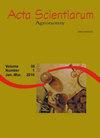血管黄单胞菌的敏感性。维管菌对化学药剂的影响及玉米细菌性叶斑病的化学防治效果
IF 1.2
4区 农林科学
Q3 AGRONOMY
引用次数: 0
摘要
血管性黄单胞菌引起的细菌性叶斑病。维管病是影响玉米生产的一种新兴病害。然而,关于这种疾病管理的信息仍然有限。本研究的目的是确定体外敏感性。不同药剂对维管菌的影响及对温室条件下玉米细菌性条纹病的防治效果评价。用卡苏甘霉素、硫酸铜、氯化氧铜、氢氧化铜、氧化亚铜、生物活性铜、代森锰锌、百菌清、硫代酸甲酯和戊唑唑进行体外试验,剂量分别为1、5、10、20、50、100、200和400 μg mL−1。四株水曲霉。维管束也包括在研究中。对卡苏霉素的最小抑制浓度为50 ~ 200 μg mL-1,对无机铜化合物的最小抑制浓度为5 ~ 50 μg mL-1,对生物活性铜化合物的最小抑制浓度为100 μg mL-1。代森锰锌和戊康唑分别在5 ~ 20 μg mL-1和50 ~ 400 μg mL-1的剂量范围内抑制细菌生长。vasculorum压力。百菌清和噻吩酸甲酯在任何浓度下都不能抑制细菌的生长。以V3物候营养期玉米品种IPR 164为研究对象,在温室条件下施用卡苏霉素(3ml L-1)、氯化氧化铜(1.5 mL L-1)、生物活性铜(1ml L-1)、代森锰锌(2g L-1)、戊康唑(1ml L-1)和百菌清(2ml L-1)防治细菌性叶斑病。用108cfu mL-1悬液接种玉米植株。vasculorum。只有氯化氧铜能显著降低疾病的严重程度。然而,在测试浓度下,铜化合物对玉米植株产生了植物毒性。本文章由计算机程序翻译,如有差异,请以英文原文为准。
Sensibility of Xanthomonas vasicola pv. vasculorum to chemicals and efficiency of the chemical control of bacterial leaf streak on corn plants
Bacterial leaf streak caused by Xanthomonas vasicola pv. vasculorum is an emerging disease for corn production around the world. However, information on management of this disease is still limited. This study aimed to determine the in vitro sensibility of X. vasicola pv. vasculorum to different chemicals and to evaluate the control of bacterial leaf streak on corn under greenhouse conditions. In vitro tests were carried out with kasugamycin, copper sulfate, copper oxychloride, copper hydroxide, cuprous oxide, bioactive copper, mancozeb, chlorothalonil, methyl thiophanate, and tebuconazole at the dosages of 1, 5, 10, 20, 50, 100, 200, and 400 μg mL−1. Four strains of X. vasicola pv. vasculorum were included in the study. The minimal inhibitory concentration for kasugamycin ranged from 50 to 200 μg mL–1, whereas to the inorganic copper compounds varied from 5 to 50 μg mL–1 and to the bioactive copper was 100 μg mL–1. Further, mancozeb and tebuconazole inhibited the bacterial growth at the dosage ranging from 5 to 20 μg mL–1 and 50 to 400 μg mL–1, respectively, depending on the X. vasicola pv. vasculorum strain. Chlorothalonil and methyl thiophanate did not inhibit the growth of the bacterium at any tested concentration. The control of bacterial leaf streak under greenhouse conditions was investigated on corn plants of the cultivar IPR 164 at the V3 phenological vegetative stage, sprayed with kasugamycin (3 mL L–1), copper oxychloride (1.5 mL L–1), bioactive copper (1 mL L–1), mancozeb (2 g L–1), tebuconazole (1 mL L–1), and chlorothalonil (2 mL L–1). The corn plants were inoculated with a 108 CFU mL–1 suspension of the RL1 strain of X. vasicola pv. vasculorum. Only copper oxychloride significantly reduced disease severity. However, this copper compound caused phytotoxicity to the corn plants at the tested concentration.
求助全文
通过发布文献求助,成功后即可免费获取论文全文。
去求助
来源期刊

Acta Scientiarum. Agronomy.
Agricultural and Biological Sciences-Agronomy and Crop Science
CiteScore
2.40
自引率
0.00%
发文量
45
审稿时长
>12 weeks
期刊介绍:
The journal publishes original articles in all areas of Agronomy, including soil sciences, agricultural entomology, soil fertility and manuring, soil physics, physiology of cultivated plants, phytopathology, phyto-health, phytotechny, genesis, morphology and soil classification, management and conservation of soil, integrated management of plant pests, vegetal improvement, agricultural microbiology, agricultural parasitology, production and processing of seeds.
 求助内容:
求助内容: 应助结果提醒方式:
应助结果提醒方式:


